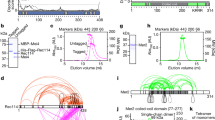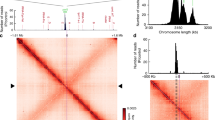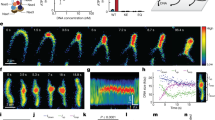Abstract
Chromosome condensation occurs in mitosis before the separation of sister chromatids, and requires DNA topoisomerase II (refs 1,2) and a group of proteins called SMCs3,4,5. The resulting condensed chromosomes in metaphase have a complex hierarchical structure6,7. SMCs, the components of condensed chromosomes, are also required for the separation of sister chromatids and gene dosage compensation, and are found in a range of organisms from yeasts to mammals8,9,10,11,12,13. However, the mechanisms by which the SMCs contribute to chromosome condensation are unknown. We have studied chromosomes in fission-yeast SMC mutants cut3-477 and cut14-208 (ref. 9), which remain largely non-condensed during mitosis at the restrictive temperature (36 °C)9. To test their role in DNA condensation, we isolated the proteins Cut3 and Cut14 as an oligomeric complex, and tested their interactions with isolated DNA. The complex efficiently promoted the DNA renaturation reactions (the winding up of single-strand DNAs into double helical DNA) as much as ∼70-fold more efficiently than RecA14, which is a bacterial protein with similar activity. The activity of the mutant complex was heat sensitive. As DNA winding by renaturation is a potential cause of supercoiling, the SMC complex may be implicated in promoting the higher-order DNA coiling found in condensed chromosomes.
This is a preview of subscription content, access via your institution
Access options
Subscribe to this journal
Receive 51 print issues and online access
$199.00 per year
only $3.90 per issue
Buy this article
- Purchase on Springer Link
- Instant access to full article PDF
Prices may be subject to local taxes which are calculated during checkout




Similar content being viewed by others
References
Swedlow, J. R., Agard, D. A. & Sedat, J. W. Chromosome structure inside the nucleus. Curr. Opin. Cell Biol. 5, 412–416 (1993).
Swedlow J. R. Agard D. A. & Sedat J. W. Chromosome structure inside the nucleus. Curr. Opin. Cell Biol. 5, 412–416 (1993).
Hirano, T., Mitchison, T. J. & Swedlow, J. R. The SMC family: from chromosome condensation to dosage compensation. Curr. Opin. Cell Biol. 7, 329–336 (1995).
Gasser, S. M. Coiling up chromosomes. Curr. Biol. 5, 357–360 (1995).
Koshland, D. & Strunnikov, A. Mitotic chromosome condensation. Annu. Rev. Cell Dev. Biol. 12, 305–333 (1996).
Boy de la Tour, E. & Laemmli, U. K. The metaphase scaffold is helically folded: sister chromatids have predominantly opposite helical handedness. Cell 55, 937–944 (1988).
Belmont, A. S., Sedat, J. W. & Agard, D. A. Athree dimensional approach to mitotic chromosome structure: evidence for a complex hierarchical organization. J. Cell Biol. 105, 77–92 (1987).
Strunnikov, A. V., Larionov, V. L. & Koshland, D. SMC1: an essential yeast gene encoding a putative head-rod-tail protein is required for nuclear division and defines a new ubiquitous family. J. Cell Biol. 123, 1635–1648 (1993).
Saka, Y.et al. Fission yeast cut3 and cut14, members of a ubiquitous protein family, are required for chromosome condensation and segregation in mitosis. EMBO J. 13, 4938–4952 (1994).
Hirano, T. & Mitchison, T. J. Aheteromeric coiled-coil protein required for mitotic chromosome condensation in vitro. Cell 79, 449–458 (1994).
Saitoh, N., Goldberg, I. G., Wood, E. R. & Earnshaw, W. C. ScII: an abundant chromosome scaffold protein is a member of a family of putative ATPase with an unusual predicted tertiary structure. J. Cell Biol. 127, 303–318 (1994).
Chuang, P.-T., Albertson, D. G. & Meyer, B. J. DPY-27: a chromosome condensation protein homolog that regulates C. elegans dosage compensation through association with the X chromosome. Cell 79, 459–474 (1994).
Strunnikov, A. V., Hogan, E. & Koshland, D. SMC2, a Saccharomyces cerevisiae gene essential for chromosome segregation and condensation defines a subgroup within the SMC-family. Genes Dev. 9, 587–599 (1995).
Bryant, F. R. & Lehman, I. R. On the mechanism of renaturation of complementary DNA strands by the recA protein of Escherichia coli. Proc. Natl Acad. Sci. USA 82, 297–301 (1985).
Maundrell, K. nmt1 of fission yeast. J. Biol. Chem. 265, 10857–10864 (1990).
Côté, J., Quinn, J., Workman, J. L. & Peterson, C. L. Stimulation of GAL4 derivative binding to nucleosomal DNA by the yeast SW1/SNF complex. Science 265, 53–60 (1994).
Funabiki, H.et al. Cut2 proteolysis required for sister-chromatid separation in fission yeast. Nature 381, 438–441 (1996).
Bryant, F. R., Menge, K. L. & Nguyen, T. T. Kinetic modeling of the RecA protein promoted renaturation of complementary DNA strands. Biochemistry 28, 1062–1069 (1989).
Jessberger, R., Riwar, B., Baechtold, H. & Akhmedov, A. T. SMC proteins constitute two subunits of the mammalian recombination complex RC-1. EMBO J. 15, 4061–4068 (1996).
Chikashige, Y.et al. Composite motifs and repeat symmetry in S. pombe centromeres: direct analysis by integration of NotI restriction sites. Cell 57, 739–751 (1989).
Hirano, T., Kobayashi, R. & Hirano, M. Condensins, chromosome condensation protein complexes containing XCAP-C, XCAP-E and a Xenopus homolog of the Drosophila Barren protein. Cell 89, 511–521 (1997).
Connelly, J. C. & Leach, D. R. F. The sbcC and sbcD genes of Escherichia coli encode a nuclease involved in palindrome inviability and genetic recombination. Genes Cells 1, 285–291 (1996).
Bhat, M. A., Philp, A. V., Glover, D. M. & Bellen, H. Chromatid segregation at anaphase requires the barren product, a novel chromosome-associated protein that interacts with topoisomerase II. Cell 87, 1103–1114 (1996).
Acknowledgements
We thank T. Horii, H. Ogawa and Y. Adachi for help and advice; T. Hirano for data before publication; and T. Hyman for critically reading the manuscript. This work was supported by grants from the Ministry of Education, Science and Culture of Japan, the Japan Science Technology Foundation (CREST), and the Human Frontier Science Promotion Organization. T.S. is the recipient of a Japan Science Promotion Society fellowship.
Author information
Authors and Affiliations
Corresponding author
Rights and permissions
About this article
Cite this article
Sutani, T., Yanagida, . DNA renaturation activity of the SMC complex implicated in chromosome condensation. Nature 388, 798–801 (1997). https://doi.org/10.1038/42062
Issue Date:
DOI: https://doi.org/10.1038/42062
This article is cited by
-
Potential roles of condensin in genome organization and beyond in fission yeast
Journal of Microbiology (2021)
-
Multistep assembly of DNA condensation clusters by SMC
Nature Communications (2016)
-
In vitro topological loading of bacterial condensin MukB on DNA, preferentially single-stranded DNA rather than double-stranded DNA
Scientific Reports (2016)
-
Condensin targets and reduces unwound DNA structures associated with transcription in mitotic chromosome condensation
Nature Communications (2015)
-
Condensins and 3D Organization of the Interphase Nucleus
Current Genetic Medicine Reports (2013)
Comments
By submitting a comment you agree to abide by our Terms and Community Guidelines. If you find something abusive or that does not comply with our terms or guidelines please flag it as inappropriate.



